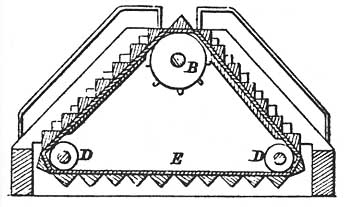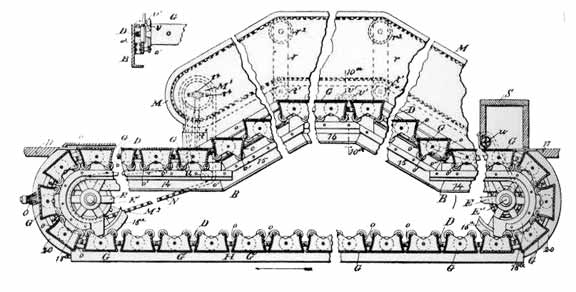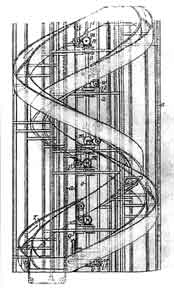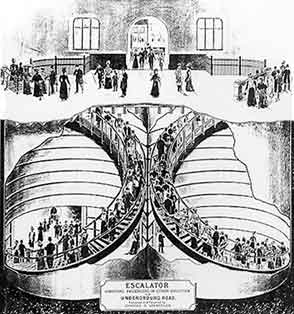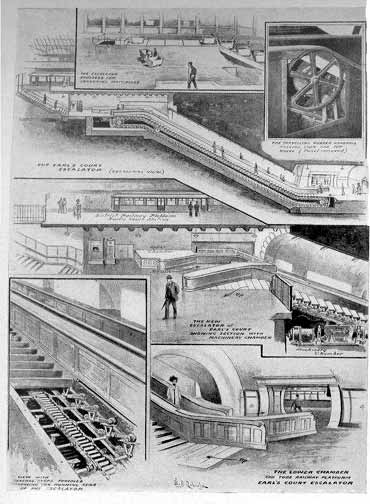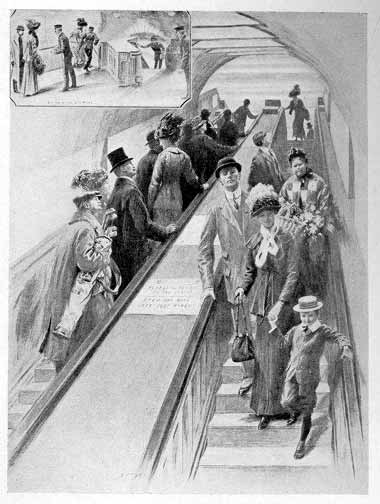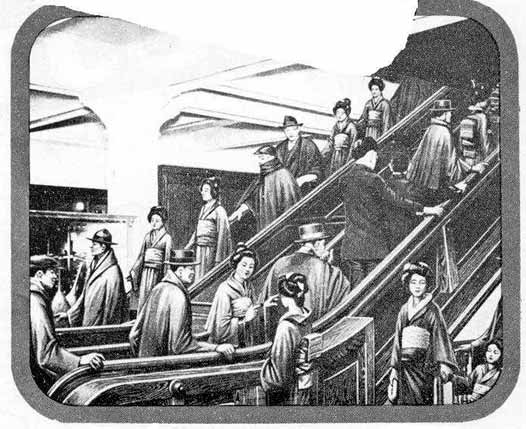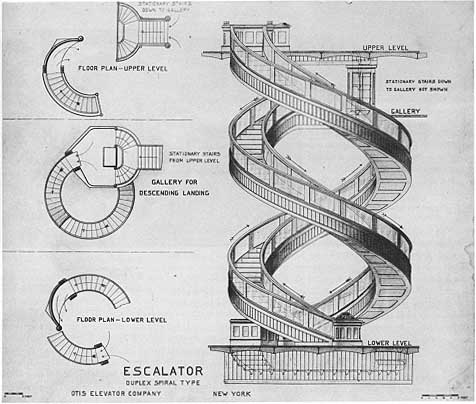|
(f-4-11)
|
|
On August 9, 1859, the U.S.A. Patent Office granted Nathan
Ames a patent for a revolving stairway in the form of an equilateral
triangle. A substantial amount of agility would have been required
to mount or dismount this device; however, this rendering is
the first idea for such a lifting mechanism. Neither Ames nor
his moving stairway was heard from thereafter.
(Graphic Source: Der Fahrstuhl)
|
|
 |
(f-4-14)
|
|
Jesse Reno's initial moving stairway invention in 1891 was more
of an inclined bicycle. The bold rider sat astride whereas the
more gentile lady was expected to ride "sidesaddle." This device,
installed by Reno as a pleasure ride at Coney Island in Brooklyn,
had a vertical rise of seven feet, an inclination of 25 degrees
and a speed of 75 feet per minute.
(Graphic Source: Der Fahrstuhl)
|
|
 |
(f-4-20)
|
|
On April 16, 1887 G.A. Wheeler applied for a patent on a moving
stairway with most of the ingredients of that known in our modern-day.
The patent was granted on January 17, 1899. The continuous chain
drove pallet steps, triangular in shape that could be swept through
combplates at the terminals. Note the number of flat steps leading
to the upward transition giving the passenger time to become accustomed
to the movement. Manufacturers only adopted this feature of an
extended flat approach about 90 years later. Within three years
Wheeler had made improvements in the drive, step design and handrail
drive mechanism, shown in the next exhibit.
|
|
 |
(f-4-3)
|
|
Patents for moving stairways had been granted to George A. Wheeler
in 1892 and to Charles D. Seeberger in 1898. They joined forces
and developed a mechanism similar to the accompanying drawing
and sold the design to Otis Elevator Company in 1899. Seeberger
is said to have coined the word, "escalator." Competition between
the two moving stairway companies -- The Reno Electric Stairway
and Conveyors Organization -- became intense. Eventually, in 1911,
Otis bought Reno's Company and for a time sold both the Seeberger
"A" type and the Reno or Duplex Cleat type. The first two escalators
installed in the London Underground in 1911 were the Seeberger
"A" type.
(Graphic Source: Der Fahrstuhl)
|
|
 |
(f-4-16, f-4-19)
|
|
Jesse Reno moved to London in 1900 and devoted himself to creating
what would become the first walkway. In 1902, his efforts were
realized and his walkway was presented at the Earls Court Exhibition
and then utilized as an amusement ride for four years. The patent
for the flexible chain drive (near left graphic) was held by William
Henry Aston, making the unique electric walkway a joint engineering
effort of both men and their companies. The mechanism enjoyed
a handrail that moved in unison with the ascending and descending
pallets (far left graphic). Thewalkway occupied a 23-foot diameter
shaft with a vertical rise of 35 feet. The installation was made
at the Holloway Road Station of the Great Northern, Piccadilly
and Brampton Railway but apparently was never approved by safety
inspectors for public use. Its failure had an adverse effect upon
Reno and his company. Within five years, he sold his patents to
Otis and returned to the U.S. in 1911. Unfortunately, those lowering
the tracks did not recognize the significance of this pioneering
effort. The mechanism was not properly dismantled and only discovered
83 years later during the station's modernization!
(Graphic Source: Moving People from Street to Platform)
|
|
 |
|
|
Seeberger was making a run at creating a practical Spiral Escalator
between 1900 and 1910. He designed many unique parts, including
the "C" shaped handrail. His mechanism was never placed in operation,
despite the superior engineering of components. The failure of
these two walkways by two engineering greats of their time no
doubt discouraged others from assuming the challenge until Japan's
Mitsubishi developed and marketed a practical Spiral Escalator
in the late 1980s.
(Graphic Source: Moving People from Street to Platform)
|
|
 |
(f-4-1; f-4-2)
|
|
Escalator at Earls Court Station, London. The Illustrated London
News of October 14, 1911 wrote, "London has come into line with
New York in the matter of the Escalator. The passenger on his
way from the Piccadilly tube station steps on a platform going
90 feet per minute and finds that they immediately form into a
perfect stairway. For descent it is the same. Should a passenger
wish to move faster than the stairs he can run up of down. The
fascinating device combines pleasure with business and not a few
make the up and down trip several times, enjoying the sensation."
(Graphic Source: The Indicator by Otis)
|
|
 |
(f-4)
|
|
Japan's first escalators were installed by Otis in 1914 in the
Mitsukoshi Department Store.
(Graphic Source: ELEVATOR WORLD, October 1971)
|
|
 |
|
|
Charles Seeberger developed this plan of a duplex spiral escalator
for Otis Elevator Company about 1900. It would be about 85 years
before an operational spiral escalator would be installed by
Mitsubishi of Japan.
(Graphic Source: Der Fahrstuhl)
|
|
|









